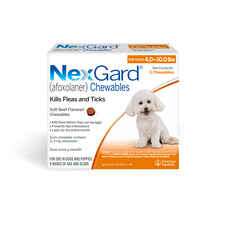Flea and Tick: FAQs About Fleas
Doctor of Veterinary Medicine

While efforts are made to answer all questions as quickly as possible, if an immediate answer is required or if your pet is in need of urgent or emergency care, contact your pet's veterinarian immediately.
Doctor of Veterinary Medicine

You will receive an answer from Dr. Lindsay and our vet/tech team as soon as possible, usually the same day.
All answers are provided for informational or educational purposes only, and are intended to be a supplement to, and not a substitute for, the expertise and professional judgment of your pet's veterinarian.
It may be necessary to consult your pet's veterinarian regarding the applicability of any opinions or recommendations with respect to your pet's symptoms or medical condition.
CloseDoctor of Veterinary Medicine

An error has occurred, please reload the page and try again.
CloseWhile efforts are made to answer all questions as quickly as possible, if an immediate answer is required or if your pet is in need of urgent or emergency care, contact your pet's veterinarian immediately.
There is no answer related to your question

What are Fleas?
Fleas are wingless external parasites known for their biting and blood-sucking abilities. Fleas look like copper or blackish pepper flakes, about 1/8 inch long—when you get to see them. Most fleas dash out of sight, heading toward cover. When you do see fleas, you know a dozen of their comrades are in hiding. Flea eggs are approximately 1/64th of an inch and fall off pets and to the floor, usually resting in cracks between boards, along moldings, or in leaf litter.
Even though adult fleas can be easily killed, it is usually the flea eggs that are the major problem, because they are harder to find and have a hard exterior shell protecting them.
Despite its name, the cat flea is the number one external parasite of both cats and dogs and over 95% of the flea population exists in carpet and grass. To properly control a flea infestation you should use pet flea control products and remove fleas in the surrounding environment by using a home flea treatment. And if your pet spends any time outdoors, make sure you thoroughly use flea yard spray.
- Do cat fleas also attack dogs?
- Has the cat flea developed resistance to flea products?
- Do fleas attack wild animals?
- Do adult fleas jump on and off animals?
- What's flea dirt?
- How do fleas suck blood?
- Can fleas suck enough blood to kill pets?
- How fast do fleas feed?
- How quickly do fleas lay eggs?
- How quickly do flea eggs hatch?
- How long can newly hatched fleas live before they attach to a pet?
- How quickly can a flea go through its entire life cycle (egg, larva, pupa, and adult)?
- How long does it take one flea to develop into a million fleas?
- How do fleas survive the freezing winters?
- Why do fleas prefer pets to people?
- Do fleas like some areas of the pet more than others?
- Does everyone have a flea problem?
- Do fleas transmit diseases?
Yes. Ctenocephalides felis, the cat flea, is the number one external parasite of cats and dogs, and several other family pets: rabbits, guinea pigs and ferrets. So, don't get confused by the name; it's called cat flea, but it is the number one flea of all pets, dogs included.
Yes. The cat flea is resistant to more products than any other type of flea, but rotating products helps decrease resistance.
Yes. Fleas plague wild animals as much as they plague pets. Wild animals that carry fleas, and can deposit flea eggs and larvae in your yard, include raccoons, opossums, deer, cattle, coyotes, foxes, bobcats, skunks, ferrets, and Florida panthers.
No. Once an adult flea has found a pet to feed on, it remains on the pet to feed, mate, and lay eggs. The eggs fall off the pet and the larvae and pupa mature off the pet in the carpet and grass.
The female consumes 15 times her body weight in blood, which passes through her digestive system and is defecated out onto the skin. These comma-shaped feces are called flea dirt. The female flea lays her weight in eggs daily, and can lie for over 100 days.
Fleas drink blood using two mouth parts. One part squirts saliva and partially digested blood into the host, and the other sucks blood from the host. This is how fleas transmit pathogens, like tapeworms, to your pet.
Yes. Fleas have taken enough blood to kill kittens, puppies, calves, lambs, and goats.
About 60% of fleas will feed within 5 minutes of jumping onto your pet, and almost 100% of fleas are engorged with blood within 1 hour of being on your pet.
The female lays eggs 24-36 hours after her first blood meal. Fleas lay up to 50 eggs a day, which is equal to their body weight. They can lay this many eggs because they suck up 15 times their body weight in blood daily. This blood lust can continue for 3 months.
If the temperature is 95°F and there is 70% humidity, half of all flea eggs hatch within 36 hours. If it is only 55°F, half of all flea eggs will hatch within 6 days.
In a humid environment, over 60% of newly hatched fleas can live without a host for 2 months. In a cool, dry environment, only 10% will live without an immediate host. Humidity is the key to flea survival.
The entire flea life cycle can take place in less than 3 weeks.
6 weeks. In 3 weeks, one flea can pass through its entire life cycle and can lay 1000 eggs. In another 3 weeks, those eggs can hatch and lay 1,000 eggs each, so within 6 weeks, it is possible to have a million new fleas.
Fleas, eggs, larvae or pupae die if the temperature falls to 37°F for 10 days. Still, fleas survive up north where it's much colder than 37°F. Why? These fleas survive on stray domestic animals and wild mammals—raccoons and opossums and in:
- Barns
- Heated garages
- Kennel bedding
- Carpets
- Pick-ups carrying hay bales for traction
Because fleas prefer dark areas, fleas gravitate to haired areas on your pet's skin. Because pets have more hair than people (more dark hiding places), fleas prefer pets to people. Because fleas prefer darkness, they scatter from sight if we part the hair to look for them. They can be very difficult to find.
Yes, fleas prefer the rump and the head where your pet cannot reach to remove them. Fleas also find the belly a choice area to invade. On some cats, you'll find fleas high along the spine between the shoulder blades.
Unfortunately, flea problems are widespread, and few homes are spared; not even the spotless homes. Veterinarians' homes are no different. They have flea problems too.
One veterinarian spent 3 months ridding an apartment in Chicago of fleas. In fact, fleas tormented him so much that he became a veterinary dermatologist and devotes himself to making others have an easier time of it with fleas than he had.
In the South, fleas are a year-round problem because they survive during the easy winters. In the North, winter temperatures fall, but fleas survive in heated garages, barns, hay bales, on wildlife, and on pets that stay indoors.
Humidity is probably the single most important factor in flea survival, but in hot, dry areas with low humidity, fleas survive because they can remain cocooned for months. Parts of the world that are exceptionally hot or dry, though, have no resident flea problems at all. Of course, most of us wouldn't want to live there either.
Yes, fleas transmit tapeworms and several infectious diseases, including the plague. Whenever your pet snaps at a flea and swallows it, it has exposed itself to Dipylidium caninum, a tapeworm that attaches to the small intestine where it sucks up nutrients. In a few weeks, you'll find dried, tan, rice-like tapeworm segments attached to the pet's rectum or in the feces. These tapeworm segments carry eggs and can eventually infect humans and other pets. One more reason to prevent fleas.
 Swipe
Swipe




























